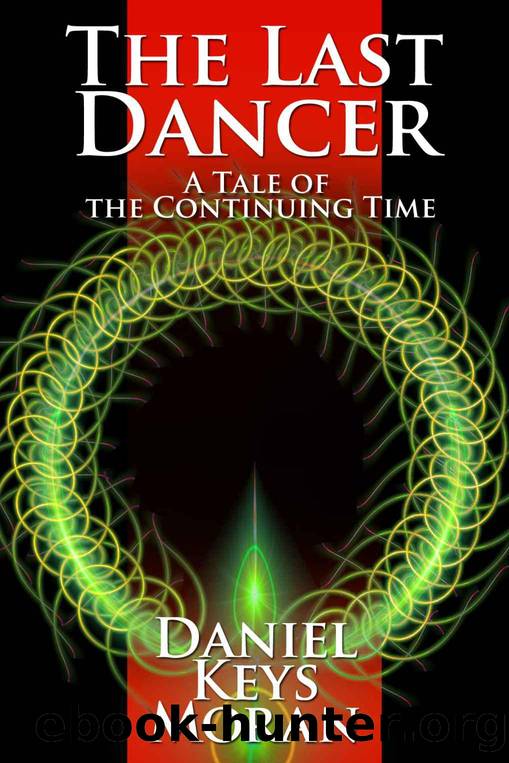The Last Dancer (Tales of the Continuing Time) by Moran Daniel Keys

Author:Moran, Daniel Keys [Moran, Daniel Keys]
Language: eng
Format: epub
Publisher: FS&
Published: 2011-04-20T22:00:00+00:00
BY THE END of the third cold season â winter, the exiles had taken to calling it, another of the new words â the exiles had ceased bothering to plant crops of the World. They grew poorly, with yields nothing like those they gave on the World, for this planet lacked the bacteria they required for proper growth. Instead, at the end of the third cold season, they planted local crops; a shrub that provided tart red berries, each berry about the size of a manâs thumb; and a crawling vine that bore another kind of red fruit, a bulbous thing with a thin skin. Both of them were sour, though it was a different kind of sourness in each, and Dvan could not find it in him to think much of them. But they grew easily, met most of the bodyâs needs, and, after being dried in the sun, stored well over the course of the winter.
They had one great advantage, from the exilesâ point of view; they did not need to be taken back to the ship for processing. Straight out of the ground they could be digested by even the youngest child.
The fourth winter was difficult, but nobody died of starvation; by the time of the fourth warm season, the exiles had four children among them, one of them a boy. It was a remarkable number, for a community of less than four thousand; at this rate, their numbers would double within a mere ten or twelve centuries.
In the fifth year, guided by the information stored in their corders, the small colony of exiles at last began to flourish. After several years of trial and error, the engineers started turning out decent steel at good clip; it was the catalyst that drove everything else. Farming grew easier, as ploughs came into use; shovels and picks made it possible to dig channels to divert water from the distant river to the fields, where it was needed, rather than relying upon the rains to water the crops. The colonyâs original crude buildings, some no better than mud-thatched huts, were torn down, one by one, and replaced with sturdy buildings with thick log walls.
Dvan noticed about that time that in conversation he had begun referring to the town as the âcolony.â It was a shift in perception that many of the Shield shared. With food at last assured, without the Aneda to guide their breeding, the colony saw an explosion of children that amazed and disturbed the Shield. In the sixth year, eight children were born; in the seventh, better than twenty. There was something flatly indecent about it, many of the Shield felt, and Dvan understood the feeling; animals bred so, not the Flame People.
One evening, over dinner, the Sentinel Marah said, in response to a comment from Dvan on the subject, âWhat makes you think them People of the Flame?â
It stopped all conversation around the firepit. Shield watched Dvan, listened to see how he would respond.
âThey are heretics, surely.
Download
This site does not store any files on its server. We only index and link to content provided by other sites. Please contact the content providers to delete copyright contents if any and email us, we'll remove relevant links or contents immediately.
Sita - Warrior of Mithila (Book 2 of the Ram Chandra Series) by Amish(54505)
The Crystal Crypt by Dick Philip K(36596)
Cat's cradle by Kurt Vonnegut(15082)
Always and Forever, Lara Jean by Jenny Han(14704)
Ready Player One by Cline Ernest(14408)
The Last by Hanna Jameson(10090)
Year One by Nora Roberts(9610)
Persepolis Rising by James S. A. Corey(9124)
The remains of the day by Kazuo Ishiguro(8729)
Red Rising by Pierce Brown(8508)
Never let me go by Kazuo Ishiguro(8508)
Dark Space: The Second Trilogy (Books 4-6) (Dark Space Trilogies Book 2) by Jasper T. Scott(8045)
The handmaid's tale by Margaret Atwood(7631)
The Circle by Dave Eggers(6984)
Frank Herbert's Dune Saga Collection: Books 1 - 6 by Frank Herbert(6845)
The Testaments by Margaret Atwood(6650)
Legacy by Ellery Kane(6512)
Pandemic (The Extinction Files Book 1) by A.G. Riddle(6395)
Six Wakes by Mur Lafferty(6053)
